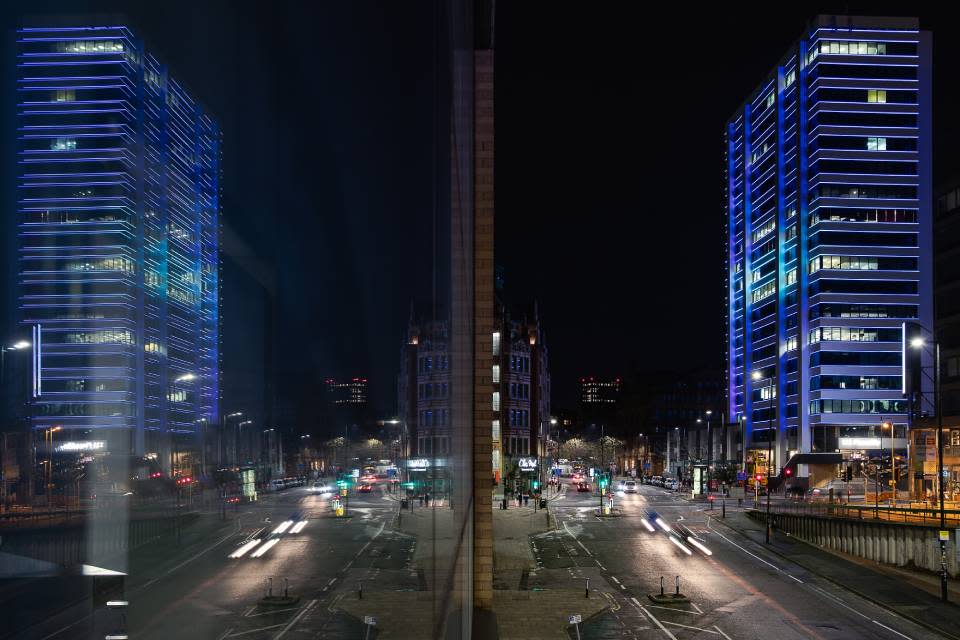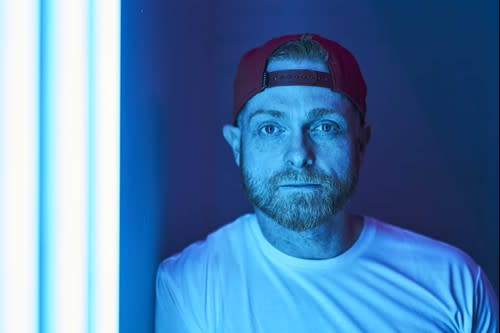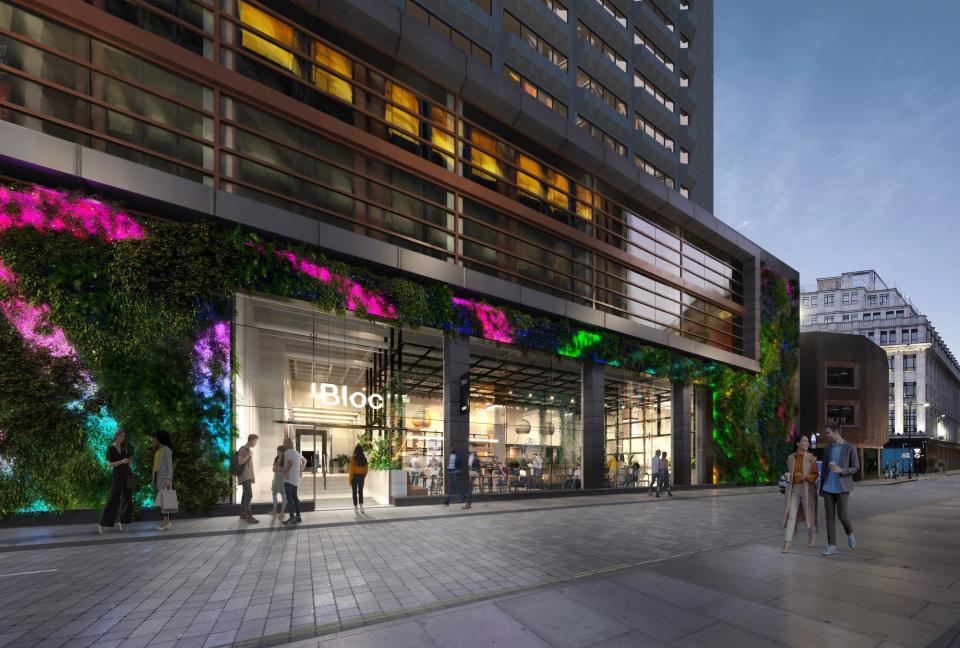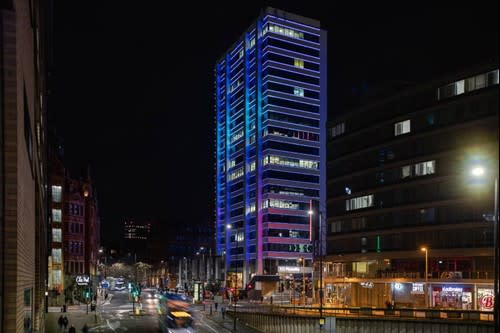Artist interview: Luke Artingstall, Director and Founder at Artin Light
By Bruntwood Works


From a 200ft LED ground-breaking external lighting concept at 111 Piccadilly in Manchester to a dynamic and immersive light experience in our wellbeing studio at West Gate in Leeds, we catch up with artist, Luke Artingstall, to talk all things light art.
1. Tell us about where you passion and journey for lighting began
So, I fell in love with lighting design whilst studying Interior Design at Salford University. I think ultimately I was always drawn to light from an early stage in life, however whilst at University I had the opportunity to explore this in the conceptual ideas I developed, and as such this amplified my passion for light even more. For me I love the way light can transform a space, and also the emotional impact it has as well. I love the dream-like qualities light can bring in all forms of design and this is what drives my passion.
2. Can you describe the lighting designs have you been working on for Bruntwood Works?
We have worked on some truly amazing projects with Bruntwood Works over the last 12 months, and all of which have given us the opportunity to push the creative boundaries of lighting design in real life scenarios.
111 Piccadilly is currently a standout project given its iconic stature and position within one of the key gateways into Manchester city centre. Focusing on the external lighting as a starting point, I have to take my hat off to Bruntwood Works, for supporting and believing in this vision, which on a personal level has been truly humbling. It's amazing to see investment being made at this level which supports the creative arts, and back the importance of this in the cities we dwell in.
Putting lighting aside, I wanted to use this opportunity to celebrate the importance of creativity and Manchester’s vibrant culture and community, in the hope that the project helps inspire members of the public who pass by the building. As with any dynamic media-based design, for me the fundamental aspect of this is the visual content which is used on the system. For 111 Piccadilly we have designed bespoke motion graphics and content, which in my opinion has explored visual techniques for transforming buildings and the way they are viewed using light.
Looking at the interior lighting design scheme we have worked on at Bloc, it has given us the opportunity to push more hospitality driven lighting design techniques, which in a commercial setting has now become more prominent. These types of space are social hubs where interaction, collaboration and socialising happen. We’re building mini communities within these spaces which is so important at every level, from social to physical wellbeing. As a lighting designer, it’s important we look at these places and design schemes which are flexible, provide variation, and respond to how we choose to spend time within them. It's fundamental that we also look to create environments which have the ability to change the atmosphere throughout the day.
Bloc, which will launch in Spring 2021, will be an amazing collaborative space which will have the capability of transitioning from day to night with dynamic scene setting lighting, and then also flipping it on its head by creating saturated coloured wash schemes for events, giving the building a whole new character. Externally we have designed a scheme which I can't wait to come to fruition!

3. What gives you inspiration?
It’s tricky to put an exact finger on this as inspiration comes from so many different avenues. As always, it’s also important to explore the history or each project, but I also take inspiration from personal experiences and visions. I always look at projects and try to visualise them in different contexts. So take 111 Piccadilly for example, I looked at the building and pictured how it could be used as backdrops for a scenario such as a sci-fi based film, giving it dream-like qualities!
I think it’s important we try to design spaces which also make you lose context of where you are and that’s what really inspires me. Old school sci-fi and retro 80’s artwork really resonate with me, as it’s something I was always drawn to as a child, and I suspect this has an underlying influence on my work today.
4. What is your creative process when approaching light design?
As a lighting designer the concept stage is hugely important and a really exciting part of any project. It gives us an opportunity to really push our creative ideas and tell the story of our design.
I love collaborating with clients and other designers, and always try to push the boundaries of visual lighting design creating schemes with impact. It's important we visually explore all options in the conceptual lighting design process, as we can see the pros and cons to each design, and how this sits within the context of the environment, the building or the space is positioned within. We have to aim high, and look to push the boundaries of what’s possible, because if we don’t step out of our comfort zone we will never progress.
4. How does using light as art form differ from other mediums?
I’m always going to be lighting-biased, but I do believe there is something beautiful about light and how working with it can create unexpected reactions you can’t always foresee. I believe the concept of being drawn to the light resonates in all of us, and for me I love how different people perceive and react to light in their own individual way. Light can change with environments and objects in different ways, playing with your spatial perceptions, as well as the subconscious impact it’s having on your thoughts and memories. Combining these qualities with technology, we can be bold as well as delicate and intricate, and for me this is why I love using light as a form of artistic expression.
5. What do you want audiences to take from your work?
It’s a great but tricky question! I think ultimately it’s about being passionate about what you do and try to follow your heart and enjoy the work you do. I’m passionate about light because I believe it’s a medium which attracts and has qualities which inspires all of us. Ultimately, I hope my love for light art is conveyed through my work, and if this helps inspire more people to follow what they enjoy and use creativity to express themselves, I will be a very happy man.
6. How can lighting affect the workspace environment?
It's so important we look at both natural and artificial lighting in the development of workspaces. From physical and mental wellbeing, natural lighting should always be considered as the main source of light within the spaces we work. However, we must ensure this is balanced with visual comfort through artificial lighting, allowing the spaces we use to transition and adapt to the way we work within buildings. As a lighting designer I also believe it’s important we develop designs which provide variation and welcome change, allowing users within buildings to select their preferred type of illuminated environment, depending on the tasks they are undertaking. This may range from creating intimate and dark areas, where low level task lighting may be preferred to spaces which provide more uniform lighting, which may be more suited for detail tasks. This variation is so important and gives the users of the building their own choice in space and light.
7. How do you think light art can impact an area like Manchester City Centre?
I have so many ideas I would like to explore in Manchester and beyond using light as an art form. Manchester is in my opinion one of the greatest cities in the world. Culturally and artistically I believe we stand on our own and have so much amazing talent we need to shout about. I see great opportunities for collaboration across multiple creative disciplines ranging from digital to sculptural, and it’s my personal goal to help bring these creative collaborations into the city centre so the wider public, who may not necessarily go out of their way to see art based installations, have the opportunity to be exposed to creative art and collaborations in day to day life. Manchester has so much character and it’s time to really take the creative element of this, and celebrate the creative talent we have in the city centre.

8. Which Bruntwood Works project has given you the most satisfaction this far and why?
111 Piccadilly is an obvious project so I’m going to say West Gate in Leeds. Albeit this was only a small project, I can say this is visually one of most enjoyable projects we have done and been a part of. We designed the lighting for the Studio space which hosted interactive online fitness classes. The lighting design was developed to provide different colour palette scenarios for each type of class, creating a dynamic and immersive experience for the uses within the space. The space had its challenges in terms of design and existing architecture; however, our design was developed to extenuate the raw nature of the interior and its exposed services. The final result is very much ‘Blade Runner-esque’ in aesthetic and feels very different to your traditional studio type space.

9. Do you think more developers and light artists are starting to look at sustainable lighting solutions like Bruntwood Works has done at 111 Piccadilly by using photovoltaics to power lighting?
Absolutely. We must continue to look at ways to use light as a creative medium, using this to enhance the built environment creating a sense of place and experience within our city centres. Whilst doing this we should also be considering ways, as within any building design, to sustain or offset the energy we use in achieving this. We must be conscious that the process of creativity and sustainability is balanced. As technologies develop we will continue to look at new ways to combine creative art with sustainable energy and resources.